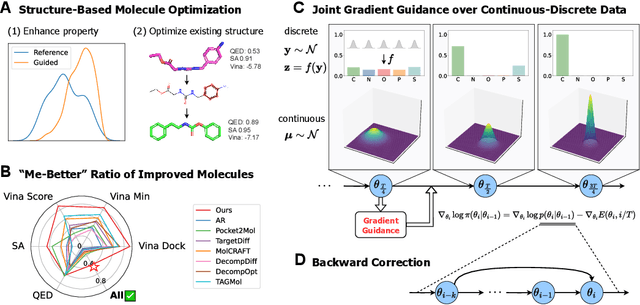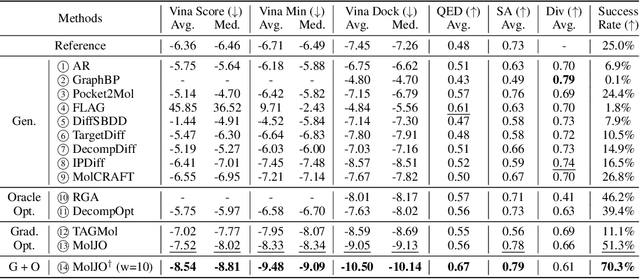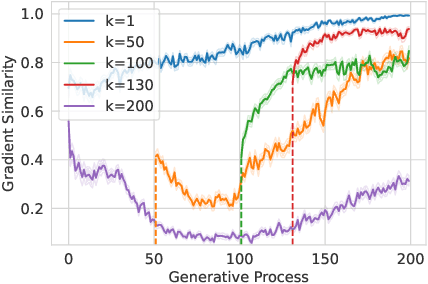Zhilong Zhang
Optimization of Private Semantic Communication Performance: An Uncooperative Covert Communication Method
Aug 11, 2025Abstract:In this paper, a novel covert semantic communication framework is investigated. Within this framework, a server extracts and transmits the semantic information, i.e., the meaning of image data, to a user over several time slots. An attacker seeks to detect and eavesdrop the semantic transmission to acquire details of the original image. To avoid data meaning being eavesdropped by an attacker, a friendly jammer is deployed to transmit jamming signals to interfere the attacker so as to hide the transmitted semantic information. Meanwhile, the server will strategically select time slots for semantic information transmission. Due to limited energy, the jammer will not communicate with the server and hence the server does not know the transmit power of the jammer. Therefore, the server must jointly optimize the semantic information transmitted at each time slot and the corresponding transmit power to maximize the privacy and the semantic information transmission quality of the user. To solve this problem, we propose a prioritised sampling assisted twin delayed deep deterministic policy gradient algorithm to jointly determine the transmitted semantic information and the transmit power per time slot without the communications between the server and the jammer. Compared to standard reinforcement learning methods, the propose method uses an additional Q network to estimate Q values such that the agent can select the action with a lower Q value from the two Q networks thus avoiding local optimal action selection and estimation bias of Q values. Simulation results show that the proposed algorithm can improve the privacy and the semantic information transmission quality by up to 77.8% and 14.3% compared to the traditional reinforcement learning methods.
Perception-Enhanced Multitask Multimodal Semantic Communication for UAV-Assisted Integrated Sensing and Communication System
Mar 25, 2025Abstract:Recent advances in integrated sensing and communication (ISAC) unmanned aerial vehicles (UAVs) have enabled their widespread deployment in critical applications such as emergency management. This paper investigates the challenge of efficient multitask multimodal data communication in UAV-assisted ISAC systems, in the considered system model, hyperspectral (HSI) and LiDAR data are collected by UAV-mounted sensors for both target classification and data reconstruction at the terrestrial BS. The limited channel capacity and complex environmental conditions pose significant challenges to effective air-to-ground communication. To tackle this issue, we propose a perception-enhanced multitask multimodal semantic communication (PE-MMSC) system that strategically leverages the onboard computational and sensing capabilities of UAVs. In particular, we first propose a robust multimodal feature fusion method that adaptively combines HSI and LiDAR semantics while considering channel noise and task requirements. Then the method introduces a perception-enhanced (PE) module incorporating attention mechanisms to perform coarse classification on UAV side, thereby optimizing the attention-based multimodal fusion and transmission. Experimental results demonstrate that the proposed PE-MMSC system achieves 5\%--10\% higher target classification accuracy compared to conventional systems without PE module, while maintaining comparable data reconstruction quality with acceptable computational overheads.
Structure-Based Molecule Optimization via Gradient-Guided Bayesian Update
Nov 21, 2024



Abstract:Structure-based molecule optimization (SBMO) aims to optimize molecules with both continuous coordinates and discrete types against protein targets. A promising direction is to exert gradient guidance on generative models given its remarkable success in images, but it is challenging to guide discrete data and risks inconsistencies between modalities. To this end, we leverage a continuous and differentiable space derived through Bayesian inference, presenting Molecule Joint Optimization (MolJO), the first gradient-based SBMO framework that facilitates joint guidance signals across different modalities while preserving SE(3)-equivariance. We introduce a novel backward correction strategy that optimizes within a sliding window of the past histories, allowing for a seamless trade-off between explore-and-exploit during optimization. Our proposed MolJO achieves state-of-the-art performance on CrossDocked2020 benchmark (Success Rate 51.3% , Vina Dock -9.05 and SA 0.78), more than 4x improvement in Success Rate compared to the gradient-based counterpart, and 2x "Me-Better" Ratio as much as 3D baselines. Furthermore, we extend MolJO to a wide range of optimization settings, including multi-objective optimization and challenging tasks in drug design such as R-group optimization and scaffold hopping, further underscoring its versatility and potential.
Stable Continual Reinforcement Learning via Diffusion-based Trajectory Replay
Nov 16, 2024



Abstract:Given the inherent non-stationarity prevalent in real-world applications, continual Reinforcement Learning (RL) aims to equip the agent with the capability to address a series of sequentially presented decision-making tasks. Within this problem setting, a pivotal challenge revolves around \textit{catastrophic forgetting} issue, wherein the agent is prone to effortlessly erode the decisional knowledge associated with past encountered tasks when learning the new one. In recent progresses, the \textit{generative replay} methods have showcased substantial potential by employing generative models to replay data distribution of past tasks. Compared to storing the data from past tasks directly, this category of methods circumvents the growing storage overhead and possible data privacy concerns. However, constrained by the expressive capacity of generative models, existing \textit{generative replay} methods face challenges in faithfully reconstructing the data distribution of past tasks, particularly in scenarios with a myriad of tasks or high-dimensional data. Inspired by the success of diffusion models in various generative tasks, this paper introduces a novel continual RL algorithm DISTR (Diffusion-based Trajectory Replay) that employs a diffusion model to memorize the high-return trajectory distribution of each encountered task and wakeups these distributions during the policy learning on new tasks. Besides, considering the impracticality of replaying all past data each time, a prioritization mechanism is proposed to prioritize the trajectory replay of pivotal tasks in our method. Empirical experiments on the popular continual RL benchmark \texttt{Continual World} demonstrate that our proposed method obtains a favorable balance between \textit{stability} and \textit{plasticity}, surpassing various existing continual RL baselines in average success rate.
WHALE: Towards Generalizable and Scalable World Models for Embodied Decision-making
Nov 08, 2024



Abstract:World models play a crucial role in decision-making within embodied environments, enabling cost-free explorations that would otherwise be expensive in the real world. To facilitate effective decision-making, world models must be equipped with strong generalizability to support faithful imagination in out-of-distribution (OOD) regions and provide reliable uncertainty estimation to assess the credibility of the simulated experiences, both of which present significant challenges for prior scalable approaches. This paper introduces WHALE, a framework for learning generalizable world models, consisting of two key techniques: behavior-conditioning and retracing-rollout. Behavior-conditioning addresses the policy distribution shift, one of the primary sources of the world model generalization error, while retracing-rollout enables efficient uncertainty estimation without the necessity of model ensembles. These techniques are universal and can be combined with any neural network architecture for world model learning. Incorporating these two techniques, we present Whale-ST, a scalable spatial-temporal transformer-based world model with enhanced generalizability. We demonstrate the superiority of Whale-ST in simulation tasks by evaluating both value estimation accuracy and video generation fidelity. Additionally, we examine the effectiveness of our uncertainty estimation technique, which enhances model-based policy optimization in fully offline scenarios. Furthermore, we propose Whale-X, a 414M parameter world model trained on 970K trajectories from Open X-Embodiment datasets. We show that Whale-X exhibits promising scalability and strong generalizability in real-world manipulation scenarios using minimal demonstrations.
Provably and Practically Efficient Adversarial Imitation Learning with General Function Approximation
Nov 01, 2024



Abstract:As a prominent category of imitation learning methods, adversarial imitation learning (AIL) has garnered significant practical success powered by neural network approximation. However, existing theoretical studies on AIL are primarily limited to simplified scenarios such as tabular and linear function approximation and involve complex algorithmic designs that hinder practical implementation, highlighting a gap between theory and practice. In this paper, we explore the theoretical underpinnings of online AIL with general function approximation. We introduce a new method called optimization-based AIL (OPT-AIL), which centers on performing online optimization for reward functions and optimism-regularized Bellman error minimization for Q-value functions. Theoretically, we prove that OPT-AIL achieves polynomial expert sample complexity and interaction complexity for learning near-expert policies. To our best knowledge, OPT-AIL is the first provably efficient AIL method with general function approximation. Practically, OPT-AIL only requires the approximate optimization of two objectives, thereby facilitating practical implementation. Empirical studies demonstrate that OPT-AIL outperforms previous state-of-the-art deep AIL methods in several challenging tasks.
Energy-Guided Diffusion Sampling for Offline-to-Online Reinforcement Learning
Jul 17, 2024



Abstract:Combining offline and online reinforcement learning (RL) techniques is indeed crucial for achieving efficient and safe learning where data acquisition is expensive. Existing methods replay offline data directly in the online phase, resulting in a significant challenge of data distribution shift and subsequently causing inefficiency in online fine-tuning. To address this issue, we introduce an innovative approach, \textbf{E}nergy-guided \textbf{DI}ffusion \textbf{S}ampling (EDIS), which utilizes a diffusion model to extract prior knowledge from the offline dataset and employs energy functions to distill this knowledge for enhanced data generation in the online phase. The theoretical analysis demonstrates that EDIS exhibits reduced suboptimality compared to solely utilizing online data or directly reusing offline data. EDIS is a plug-in approach and can be combined with existing methods in offline-to-online RL setting. By implementing EDIS to off-the-shelf methods Cal-QL and IQL, we observe a notable 20% average improvement in empirical performance on MuJoCo, AntMaze, and Adroit environments. Code is available at \url{https://github.com/liuxhym/EDIS}.
Consistency Flow Matching: Defining Straight Flows with Velocity Consistency
Jul 02, 2024



Abstract:Flow matching (FM) is a general framework for defining probability paths via Ordinary Differential Equations (ODEs) to transform between noise and data samples. Recent approaches attempt to straighten these flow trajectories to generate high-quality samples with fewer function evaluations, typically through iterative rectification methods or optimal transport solutions. In this paper, we introduce Consistency Flow Matching (Consistency-FM), a novel FM method that explicitly enforces self-consistency in the velocity field. Consistency-FM directly defines straight flows starting from different times to the same endpoint, imposing constraints on their velocity values. Additionally, we propose a multi-segment training approach for Consistency-FM to enhance expressiveness, achieving a better trade-off between sampling quality and speed. Preliminary experiments demonstrate that our Consistency-FM significantly improves training efficiency by converging 4.4x faster than consistency models and 1.7x faster than rectified flow models while achieving better generation quality. Our code is available at: https://github.com/YangLing0818/consistency_flow_matching
BWArea Model: Learning World Model, Inverse Dynamics, and Policy for Controllable Language Generation
May 27, 2024



Abstract:Large language models (LLMs) have catalyzed a paradigm shift in natural language processing, yet their limited controllability poses a significant challenge for downstream applications. We aim to address this by drawing inspiration from the neural mechanisms of the human brain, specifically Broca's and Wernicke's areas, which are crucial for language generation and comprehension, respectively. In particular, Broca's area receives cognitive decision signals from Wernicke's area, treating the language generation as an intricate decision-making process, which differs from the fully auto-regressive language generation of existing LLMs. In a similar vein, our proposed system, the BWArea model, conceptualizes language generation as a decision-making task. This model has three components: a language world model, an inverse dynamics model, and a cognitive policy. Like Wernicke's area, the inverse dynamics model is designed to deduce the underlying cognitive intentions, or latent actions, behind each token. The BWArea model is amenable to both pre-training and fine-tuning like existing LLMs. With 30B clean pre-training tokens, we have trained a BWArea model, which achieves competitive performance with LLMs of equal size (1B parameters). Unlike fully auto-regressive LLMs, its pre-training performance does not degenerate if dirty data unintentionally appears. This shows the advantage of a decomposed structure of BWArea model in reducing efforts in laborious data selection and labeling. Finally, we reveal that the BWArea model offers enhanced controllability via fine-tuning the cognitive policy with downstream reward metrics, thereby facilitating alignment with greater simplicity. On 9 out of 10 tasks from two suites, TextWorld and BigBench Hard, our method shows superior performance to auto-regressive LLMs.
Any-step Dynamics Model Improves Future Predictions for Online and Offline Reinforcement Learning
May 27, 2024Abstract:Model-based methods in reinforcement learning offer a promising approach to enhance data efficiency by facilitating policy exploration within a dynamics model. However, accurately predicting sequential steps in the dynamics model remains a challenge due to the bootstrapping prediction, which attributes the next state to the prediction of the current state. This leads to accumulated errors during model roll-out. In this paper, we propose the Any-step Dynamics Model (ADM) to mitigate the compounding error by reducing bootstrapping prediction to direct prediction. ADM allows for the use of variable-length plans as inputs for predicting future states without frequent bootstrapping. We design two algorithms, ADMPO-ON and ADMPO-OFF, which apply ADM in online and offline model-based frameworks, respectively. In the online setting, ADMPO-ON demonstrates improved sample efficiency compared to previous state-of-the-art methods. In the offline setting, ADMPO-OFF not only demonstrates superior performance compared to recent state-of-the-art offline approaches but also offers better quantification of model uncertainty using only a single ADM.
 Add to Chrome
Add to Chrome Add to Firefox
Add to Firefox Add to Edge
Add to Edge